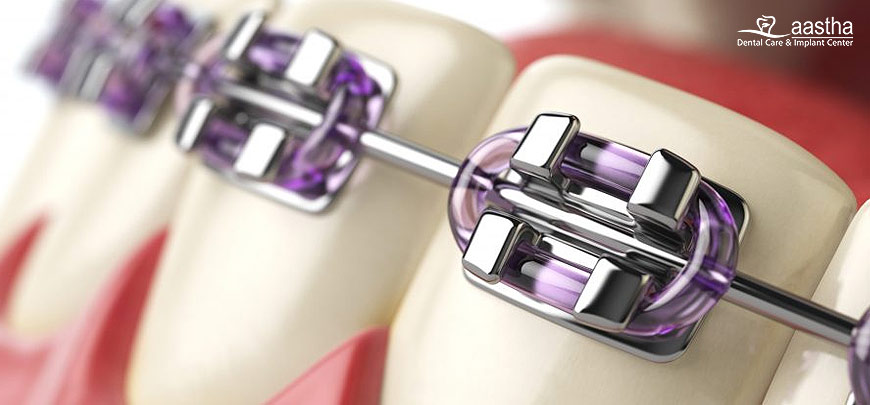Working Time
- Mon-Fri 08:00 - 20:00
Saturday 08:00 - 18:00
Contact Info
Orthodontic/Braces Treatment
What is Orthodontic/Braces Treatment?
Are you confident about your smile? This question usually has mixed responses because most people wished they had a more attractive, well-aligned smile. However, not everyone has well-aligned teeth to give them a perfect smile, isn’t it? Malalignment of teeth can be resolved with orthodontic/braces treatment.

Orthodontic treatment, commonly called as braces treatment, involves correction of misaligned teeth using braces. Apart from aligning teeth, orthodontic treatment helps to restore a person’s bite, the function of their teeth and aesthetics. In fact, it plays an important role in preventing dental conditions like cavities and gum diseases, that commonly occur in the case of malalignment.
Why Should I Get Braces?
Apart from aesthetics, most people are not really bothered about their crooked teeth. However, little do they know that their malaligned teeth can become a problem for their dental health. Many people wonder – “Why should I get braces? or “Do I need braces?”
Here are a few conditions that need braces:
- Overbite: When your upper front teeth overlap your lower front teeth in excess of 2mm, it is called an overbite and requires orthodontic treatment.
- Crossbite: In an ideal scenario, your upper teeth lie buccally(towards the cheek side) in comparison to your lower teeth. However, in some cases, the lower teeth overlap the upper and this condition is called a crossbite and can be corrected using braces.
- Open Bite: If your upper teeth fail to overlap your lower teeth, the condition is called an open bite and requires orthodontic correction.
- Misplaced midline: When the center of your upper front teeth does not line up with the center of your lower front teeth.
- Spacing: In ideal cases, adult teeth do not show spaces between them. But, many a time, due to a jaw size- tooth size mismatch or missing teeth, there is an unnatural spacing between teeth that needs orthodontic correction using braces.
- Crowding: When there is crowding of teeth, it can cause many dental issues like cavities, food lodgment, gum infections and poor aesthetics. This condition needs to be treated using braces.
- Forwardly placed teeth: Due to jaw development issues, it can result in the forwardly placed upper or lower jaw, and subsequently the teeth. If left untreated, this condition can result in many dental issues.

What are the benefits of correct teeth alignment and Braces?
Though we are not naturally born with perfectly aligned teeth, it is possible to get our teeth aligned using braces. But, what are the benefits of getting our teeth aligned?
- Efficient chewing of food
- Improvement of speech
- Improvement in dental hygiene
- Ease of maintaining good oral hygiene
- Reduced risk of cavities and gum diseases
- Reduced attrition or grinding of teeth
- Corrects protrusion of teeth, which are a higher risk of trauma
- Improves smile that helps boost confidence and self-esteem
So, dental braces are not just to improve a person’s smile or provide superior aesthetics but actually help improve oral health as well.
What are the Different Types of Braces Available?
As mentioned above, there are different types of braces that are available for patients to choose from. At Aastha Dental Care & Implant Centre, we provide a wide range of teeth braces based on the individual’s case, lifestyle choices and budget.

There three main types of braces available at Aastha Dental Care & Implant Center:
- Basic Metal Braces
These are the traditional metallic braces that have been used for many years. The orthodontists at Aastha Dental Care & Implant Centre use the top quality metallic braces to provide controlled orthodontic movements to give you a successful treatment. - Self-Ligating Metal Braces
These are advanced metallic braces that are atleast 30% faster than traditional metallic braces. These types of braces do not need elastics and therefore, are easy to clean and maintain by the patient. At Aastha Dental Care & Implant Centre, we use the best quality of self-ligating metal braces that apply low friction and make it comfortable and convenient for the patient.
Metallic Braces
As the name goes, these are metallic in nature and are of two types:
- Basic Ceramic Braces
- Self-Ligating Ceramic Braces
Ceramic Braces
Since the ‘metallic smile’ of the metal braces was a put-off for patients, ceramic braces were introduced. These are tooth-coloured and have far better aesthetics compared to metallic braces. These are further of two types, similar to metallic braces and have similar features.
Invisible Braces or Clear Aligners
These are the latest type of braces and have been introduced to make braces treatment even more aesthetic than ceramic braces. They are also called clear aligners and are essentially transparent trays that need to be worn on upper and lower teeth to bring about teeth alignment.
They are removable, invisible when worn on the teeth even at close distances and are very comfortable. These braces are customized for each patient and are manufactured using CAD/CAM technology.
While brushing and ways to floss with braces of the fixed kind can be challenging, maintaining oral hygiene with invisible braces is the easiest.
The length of orthodontic treatment for a patient is determined by multiple factors, which includes the severity of malocclusion, age, health of teeth, biologic response, etc. Nevertheless, typical orthodontic treatment takes between 12 and 36 months.
Dental braces are not painful. In most cases, there might be mild discomfort after the orthodontic wire is engaged into the brackets.
With braces fixed on the teeth, one should avoid eating food that has sticky consistency or is hard enough as it can lead to the breaking of the brackets and thus delay the total treatment time.
If you are irregular in your appointments, then the intended time period for the completion of the treatment will be prolonged and the teeth movement will be affected.
There is no age limit for getting teeth braces done. The only consideration is that the teeth should be periodontally sound.
It is not advisable to stop orthodontic treatment midway as relapse will most likely occur.
Retention phase follows orthodontic treatment. Orthodontic retainers are custom-made devices that are usually made of wires and acrylic. Their aim is to hold teeth in their new position. Once the orthodontic treatment has been completed, there will remain a risk of relapse i.e. the tendency of teeth to return to their original position. Relapse can occur due to multiple factors, which includes recoil of periodontal fibers, pressure from surrounding soft tissues, the occlusion and patient’s continued growth (as seen in adolescents). By using retainers to hold the teeth in their new position for certain length of time, the surrounding periodontal fibers are able to adapt to changes in the bone which will minimize any changes to the final tooth position after the completion of orthodontic treatment. Removable retainers are only required to be worn part-time, while fixed retainers consist of passive wire bonded permanently to the lingual surface (tongue side) of incisors.
Following are the advantages of Invisible Braces over Braces:
- Removable: With Invisible Braces, the trays can be removed, allowing you to eat and drink without food getting stuck in braces.
- Aesthetic: Clear trays may not even be noticed when the patient is wearing them.
- Comfort: Aligner trays can be more comfortable as there are no brackets involved that can otherwise create sores.
- Cleaning: It is easier to keep the Invisible Braces trays cleaner than braces.

